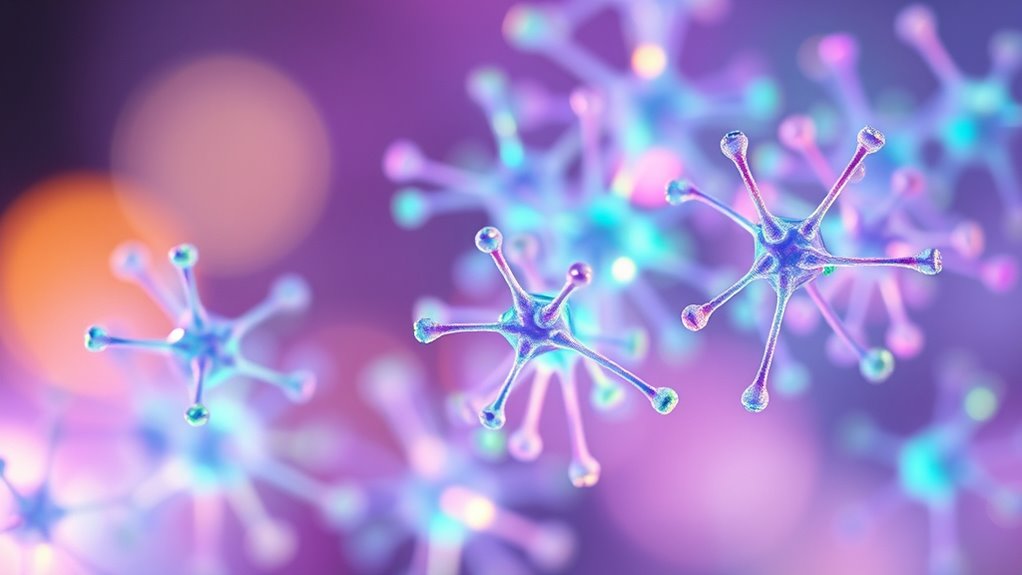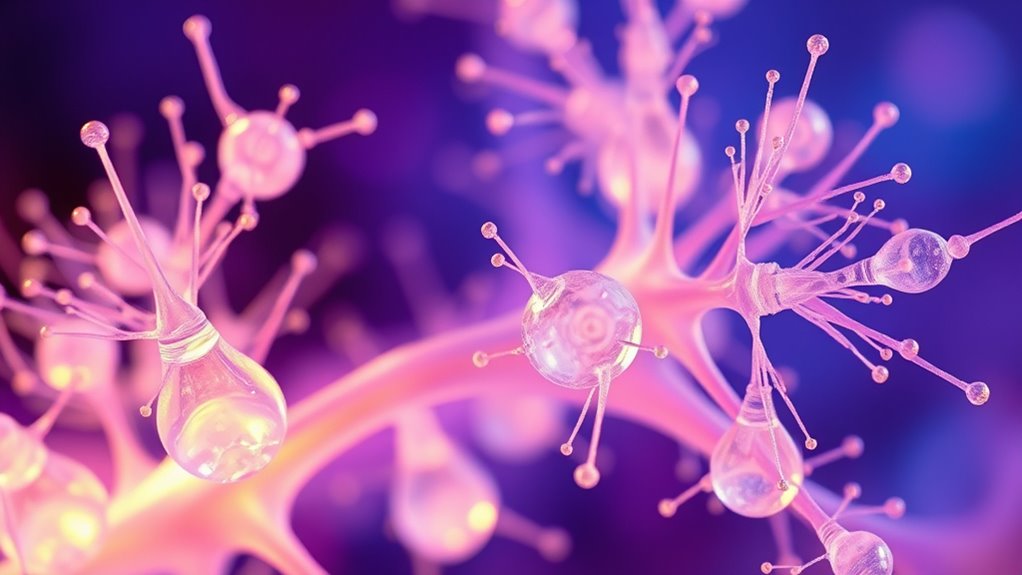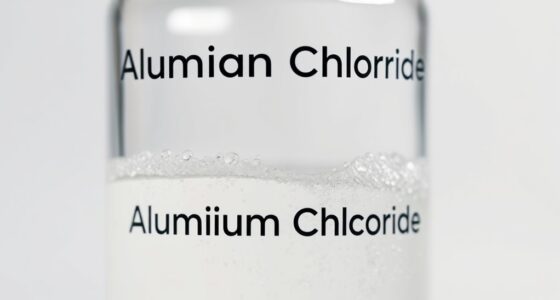When you encounter an odor, your nose detects it through molecules that bind to specific olfactory receptors on sensory neurons. These receptors recognize chemicals based on their shape and properties, triggering signals that travel to your brain’s olfactory bulb and beyond. Advances in imaging reveal how these receptors activate and distinguish different scents. To discover the intricate process behind scent detection and how your nose perceives a vast array of odors, keep exploring further.
Key Takeaways
- Odor molecules bind to specific olfactory receptors based on their shape and chemical properties.
- This binding activates receptor proteins, triggering neural signals sent to the olfactory bulb.
- Variations in receptor genes cause individual differences in scent perception.
- Structural biology reveals how odorants interact with and activate receptors at the atomic level.
- The pathway from nose to brain bypasses the thalamus, linking scents with emotion and memory.
How Our Noses Detect Odors at the Molecular Level

Your nose detects odors through a complex process at the molecular level, where specific chemicals called odorants bind to specialized receptors on sensory neurons. Each odorant has a unique molecular shape and chemical properties that determine how strongly it binds. When an odorant attaches to a receptor, it activates a specific combination of olfactory receptors, creating a distinct neural activation pattern. These patterns are sent to the olfactory bulb, where they’re integrated to form a perception of smell. Different receptors respond to different odorants, allowing you to distinguish countless scents. Recent advances, like cryo-electron microscopy, have visualized how odorants physically interact with receptor proteins at the atomic level. This detailed understanding reveals the precise molecular mechanics behind how your nose recognizes and processes smells. Breakthrough in molecular imaging now allows scientists to see exactly how odor molecules bind to their receptors, paving the way for innovations in scent detection and perception. Additionally, ongoing research into receptor molecular interactions continues to deepen our understanding of the sense of smell at a fundamental level.
The Role of Olfactory Receptor Proteins in Smell Perception

Olfactory receptor proteins are essential components of the smell detection process, as they’re responsible for recognizing and responding to odor molecules. Found in the sensory neurons of your nose, these GPCRs can detect a wide range of odors because each receptor binds to multiple molecules with different affinities. When an odor molecule binds, it causes a structural change that activates an internal G protein, leading to a cascade that produces cyclic AMP (cAMP). This, in turn, opens ion channels, depolarizing the neuron and sending electrical signals to your brain. The receptors trap odor molecules in a small pocket, with a flexible loop acting like a lid, which helps fine-tune odor detection. Variations in receptor genes contribute to differences in odor perception among individuals. Additionally, the diversity of olfactory receptor proteins is enhanced by their ability to recognize various odorant molecules, making the sense of smell highly adaptable and complex.
Chemical Traits That Influence Odor Recognition

The way molecules are recognized by olfactory receptors largely depends on their chemical traits. Molecular volatility is key; small molecules with a weight below 300 vaporize easily, enabling you to smell them. Hydrophobicity and solubility matter too—odorants need some water solubility and lipophilicity to interact effectively with receptors. The shape and size of molecules influence their ability to bind correctly, shaping how you perceive different smells. Functional groups within molecules, like aldehydes or esters, profoundly affect odor character. Additionally, chemical isomerism means that even molecules with the same formula can smell entirely different, depending on their structural arrangement. Digital olfaction uses odor fingerprints to identify and differentiate complex odor profiles, which can include subtle variations that are difficult to detect with traditional chemical analysis. Molecular structure also plays a crucial role, determining the specificity of receptor binding and odor perception. These traits collectively determine whether a molecule can trigger your olfactory receptors and produce a recognizable odor.
The Journey of Odor Molecules: From Environment to Brain

Odor molecules commence a complex journey from their source to your brain, beginning with their release into the environment. They travel through air or other media until you inhale, drawing them into your nasal cavity. Inside, they interact with mucus, which dissolves or concentrates them, making detection easier. The molecules then bind to specific olfactory receptors on sensory neurons. Each receptor is tuned to particular odorants, triggering a signaling cascade that generates electrical signals. These signals pass to the olfactory bulb, where they’re processed and bundled. From there, the information travels directly to the piriform cortex, bypassing the thalamus, and then to areas involved in emotion and memory. This pathway allows scents to evoke vivid memories and emotional responses, connecting smells deeply with your brain’s core functions. Additionally, recent research suggests that automation in sensory processing may influence how efficiently odors are detected and interpreted by the brain.
Recent Breakthroughs in Understanding Olfactory Receptor Activation

Advances in structural biology and computational techniques have transformed our understanding of how olfactory receptors detect and respond to odor molecules. Molecular studies reveal that the three-dimensional shape of odorants is *vital* for receptor binding, while molecular dynamics simulations show how odorants “jiggle” inside the receptor, influencing activation. Combining AlphaFold2 with these simulations has improved protein structure predictions and interaction insights. Cryo-electron microscopy helps visualize receptor-ligand binding, revealing the subtle structural dynamics that underlie odor detection. Additionally, understanding the binding pocket of olfactory receptors provides crucial clues about odor specificity and perception. These breakthroughs deepen your understanding of how tiny molecular shifts create the rich tapestry of smells you experience.
Frequently Asked Questions
How Do Individual Genetic Differences Affect Odor Perception?
Your genetic differences shape how you perceive odors by affecting your olfactory receptors. Variations in these receptors, like OR7D4, can change your sensitivity to specific smells, making some odors seem stronger, weaker, or even different from what others experience.
About 30% of receptor genes differ between people, influencing your preferences and perceptions. So, your unique genetics partly determine what you smell and how you interpret those scents.
Can Odor Molecules Be Engineered to Modify Scent Experiences?
Yes, you can engineer odor molecules to modify scent experiences. By understanding how molecules bind to olfactory receptors through hydrogen bonds and binding energies, scientists design new compounds that target specific receptors.
Using machine learning and computational models, you can create fragrances with tailored olfactory properties. Additionally, advanced delivery methods like airborne projection or water transport allow controlled release, enabling dynamic and customized scent experiences for various applications.
How Does Olfactory Adaptation Influence Smell Sensitivity Over Time?
Olfactory adaptation causes your smell sensitivity to decrease over time with continuous exposure. When you stay in a scent-rich environment, your nose becomes less responsive, requiring higher concentrations to detect the odor.
This process helps prevent sensory overload but also means your ability to perceive certain smells diminishes temporarily. After you leave the environment, your sense of smell gradually recovers, restoring your sensitivity to odors.
What Role Do Environmental Factors Play in Odor Detection Accuracy?
Environmental factors are like the weather that shapes your sense of smell. Temperature swings, humidity shifts, and air pollution act as gusts and storms, influencing odor molecule behavior and your nose’s sensitivity.
High temperatures boost odor emissions, while pollutants can mask or distort scents. Poor air quality, lighting, and repeated exposure also dull your detection ability.
Staying aware of these factors helps you understand why your olfactory perception can change so much.
Are There Specific Receptors for Complex Scent Mixtures?
You might wonder if specific receptors target complex scent mixtures. The answer is no; individual odorants don’t have dedicated receptors. Instead, receptors respond to multiple molecules, and mixtures activate various receptor combinations.
This overlapping response allows your nose to detect complex scents. Competitive binding and antagonism help prevent saturation, ensuring you can distinguish overlapping odors in natural environments.
Your olfactory system interprets these patterns, creating the rich perception of complex smells.
Conclusion
Now that you know how your nose detects and interprets odors at the molecular level, it’s like having your own magical alchemy shop inside your face. From the tiniest scent molecules to your brain’s perception, every whiff is a fascinating journey. Just as the ancient apothecaries cherished their fragrant herbs, modern science uncovers the secrets behind smell—reminding you that even in this age of technology, the wonder of scent remains truly enchanting.









